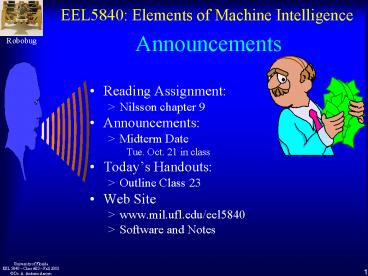Announcements - PowerPoint PPT Presentation
1 / 13
Title:
Announcements
Description:
Dr. A. Antonio Arroyo. EEL5840: Elements of Machine Intelligence. Robobug. Announcements ... Dr. A. Antonio Arroyo. EEL5840: Elements of Machine Intelligence ... – PowerPoint PPT presentation
Number of Views:26674
Avg rating:3.0/5.0
Title: Announcements
1
Announcements
- Reading Assignment
- Nilsson chapter 9
- Announcements
- Midterm Date
- Tue. Oct. 21 in class
- Todays Handouts
- Outline Class 23
- Web Site
- www.mil.ufl.edu/eel5840
- Software and Notes
2
Todays Menu
- Heuristic Search (Chapter 9)
- The Use of Evaluation Functions
- A General Graph-Searching Algorithm
- Questions when you use a General Graph-Searching
Algorithm
3
Search Strategies
- Comments/Questions on BACKTRACKing
- You MUST use a depth bound (global variable
BOUND) or you may backtrack an infinite number of
times without arriving at a solution. - How do you skip levels in order to arrive at a
solution? - Is LISP capable of handling complicated data
structures? - How much CPU time and memory is consumed by
recursive implementations? - How do we arrive at a reasonable depth bound?
- For example in the 8-puzzle
- 2 8 3 Notice that we have W4 tiles out of
place. - 1 6 4 However, the actual number of moves
required - 7 _ 5 is five and not four. Use BOUND1.5,2?W
4
Search Strategies
Figure 8.4 DFS Search
Figure 8.3 Nodes generated with DFS, Bound5
5
Search Strategies
- PROCEDURE GRAPH-SEARCH
- 1. Create a search graph, G, consisting solely of
the start node, s. Put s on a list called OPEN. - 2. Create a list called CLOSED that is initially
empty. - 3. LOOP if OPEN is empty, exit with failure.
- 4. Select the first node on OPEN, remove it from
OPEN, and put it on CLOSED. Call this node n. - 5. If n is a goal node, exit successfully with
the solution obtained by tracing a path along the
pointers from n to s in G. (see step 7.) - 6. Expand node n, generating the set, M, of its
successors and install them as successors of n in
G.
6
Search Strategies
- 7. Establish a pointer to n from those members
of M that were not already in G (i.e., not
already on either OPEN or CLOSED). Add these
members of M to OPEN. For each member of M that
was already on OPEN or CLOSED, decide whether or
not to redirect its pointer to n. For each
member of M already on CLOSED, decide for each of
its descendants in G whether or not to redirect
its pointer. - 8. Reorder the list OPEN, either according to
some arbitrary scheme or according to heuristic
merit. - 9. GO LOOP
7
Search Strategies
- Node Parent
- s -
- R11 s
- R12 R11
- R21 R11
- R22 R21
- 3 R21
- R31 3
- 1 s
- 2 3
- 5 2
- L11 s
- L12 L11
- L21 L11
- 6 L21
- L61 6
- 4 6
8
Search Strategies
- Node Parent
- s -
- R11 s
- R12 R11
- R21 R11
- R22 R21
- 3 R21
- R31 3
- 1 s
- 2 1
- 5 2
- L11 s
- L12 L11
- L21 L11
- 6 L21
- L61 6
- 4 2
9
Search Strategies
- UNINFORMED SEARCH
- BREATH-FIRST SEARCH (BFS)
- Reorder the nodes in step 8 so that the deepest
nodes are considered last (shallowest nodes are
considered first.) - Analogous to OPEN?append(OPEN,M)
- DEPTH-FIRST SEARCH (DFS)
- Reorder the nodes on OPEN in step 8 so that the
deeper nodes are considered first (shallowest
nodes are considered last.) - Nodes whose depth exceed a depth BOUND are never
generated in step 6 - Analogous to OPEN?append(M,OPEN)
- Also analogous to BACKTRACKing, except DFS
generates all the successors in parallel, whereas
BACKTRACK generates successors one at a time
10
Search Strategies
- HEURISTIC GRAPH-SEARCH PROCEDURES
- The use task-dependent information to help reduce
search. - It is often possible to specify heuristics that
reduce search without sacrificing the guarantee
of finding a minimal cost path length. - We are usually interested in search methods that
minimize the combination of costs of paths and
cost of the search averaged over all problems
likely to be encountered. - If two methods solve a particular problem, the
cheaper of the two is said to have more heuristic
power. - Heuristic information is used to order the nodes
in step 8 of GRAPH-SEARCH by way of a real-valued
evaluation function f(n). By convention, nodes
are ordered in increasing value of f.
11
Search Strategies
Figure 9.1 Using f(n)h(n)
Figure 9.2 Using f(n) g(n)h(n)
12
Search Strategies
- Example Suppose you try the 8-Puzzle using the
evaluation function f(n)d(n)W(n) where d(n)
depth(n) and - W(n) number of misplaced tiles in DBn
- f(s) d(s) W(s) or 0 4 4
- f(n1) d(n1) W(n1) 1 5 6
- f(n2) d(n2) W(n2) 1 3 4 f(n3) d(n3)
W(n3) 1 5 6
13
- The End!































